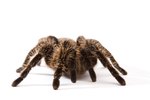
While Hawaii has relatively few venomous spiders, there are some spider species you don't want saying aloha to you while on islands. If you stick to the beach and sunbathing, chances are slim you'll encounter a dangerous arachnid. However, residential areas and forests are prime spots for the state's venomous spiders to hang out -- literally. Most of the species of concern hang from their webs, hopefully making them easy to spot.
Western Black Widow
Scientifically known as Latrodectus hesperus, the males of this species are harmless -- it's the females that give the deadly bite. Distinguishing between the two genders is relatively easy, because females are significantly larger than the males. Females are approximately a half-inch long and up to an inch wide. The males are about two-thirds that size. The adult body is glossy black with a bright-red hourglass marking on the bottom side of its abdomen. Venombyte explains they are a nocturnal species that typically are not aggressive unless attacked.
Brown Violin
This spider species, scientifically known as Loxosceles reclusa, goes by brown recluse in other parts of the United States. It also is nocturnal and unlikely to attack unless provoked. It's typically found under loose boards or in piles of bark. Most people that come in contact with this spider did not intend to do so. But that doesn't negate the potential danger from its bite -- according to the University of Hawaii, it's the culprit responsible for the bulk of deadly spider bites in the United States. Despite this fact, most bites from this spider are not deadly; a blister followed by the death of the skin at the bite site is most common.
Southern Black Widow
As is the case with this spider's western cousin, the female southern black widow spiders are the dangerous gender. The southern species bears the same color and markings of the western species with the addition of a red dot at the back end of the abdomen. Scientifically known as Latrodectus mactans, females and males of this species are the same size as western black widow spiders. However, the bite of the southern female brings on a more pronounced reaction than that of the western female: cramping, nausea, sweating, hypertension, rapid heart rate and a general feeling or uneasiness are common symptoms. These spiders prefer warm and dark locations such as garages and sheds. Humans most often get bitten by them when searching through the garage, inadvertently disturbing their home.
Brown Widow
The females of this spider species don't get movies and books named after their deadly bite as do the black widow spiders. Yet, these spiders are much more common in Hawaii than their darker counterparts, according to the University of Hawaii. Scientifically known as Latrodectus geometricus, this species also shares many of the same characteristics of black widow spiders: nocturnal behavior and males that are smaller than females. It can be a light brown to dark brown and its characteristic abdominal markings are closer to orange than red in color. The most significant difference between the brown widow and black widow spiders is the egg sack; the egg sacs of black widows are smooth, while those of brown widows are rough.
References
Photo Credits
-
Medioimages/Photodisc/Photodisc/Getty Images
Writer Bio
Amy M. Armstrong is a former community news journalist with more than 15 years of experience writing features and covering school districts. She has received more than 40 awards for excellence in journalism and photography. She holds a Bachelor of Arts in communications from Washington State University. Armstrong grew up on a dairy farm in western Washington and wrote agricultural news while in college.



